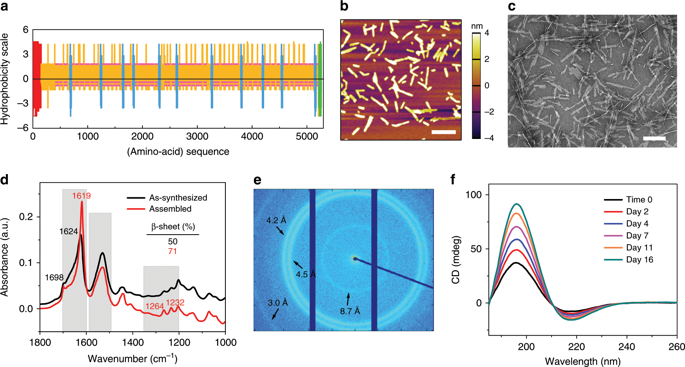当前位置:
X-MOL 学术
›
Nat. Commun.
›
论文详情
Our official English website, www.x-mol.net, welcomes your
feedback! (Note: you will need to create a separate account there.)
Polypeptide templating for designer hierarchical materials.
Nature Communications ( IF 14.7 ) Pub Date : 2020-01-17 , DOI: 10.1038/s41467-019-14257-0 Hui Sun 1 , Benedetto Marelli 1
Nature Communications ( IF 14.7 ) Pub Date : 2020-01-17 , DOI: 10.1038/s41467-019-14257-0 Hui Sun 1 , Benedetto Marelli 1
Affiliation

|
Despite advances in directing the assembly of biomacromolecules into well-defined nanostructures, leveraging pathway complexity of molecular disorder to order transition while bridging materials fabrication from nano- to macroscale remains a challenge. Here, we present templated crystallization of structural proteins to nanofabricate hierarchically structured materials up to centimeter scale, using silk fibroin as an example. The process involves the use of ordered peptide supramolecular assemblies as templates to direct the folding and assembly of silk fibroin into nanofibrillar structures. Silk polymorphs can be engineered by varying the peptide seeds used. Modulation of the relative concentration between silk fibroin and peptide seeds, silk fibroin molecular weight and pH allows control over nanofibrils morphologies and mechanical properties. Finally, facile integration of the bottom-up templated crystallization with emerging top-down techniques enables the generation of macroscopic nanostructured materials with potential applications in information storage/encryption, surface functionalization, and printable three-dimensional constructs of customized architecture and controlled anisotropy.
中文翻译:

用于设计师分层材料的多肽模板。
尽管在指导将生物大分子组装成明确定义的纳米结构方面取得了进展,但是利用分子无序的途径复杂性来实现有序过渡,同时将材料制造从纳米级扩展到宏观级仍然是一个挑战。在这里,我们以丝素蛋白为例,介绍结构蛋白的模板化结晶,以纳米级地制造高达厘米级的分层结构材料。该过程涉及使用有序的肽超分子组装体作为模板来指导丝素蛋白的折叠和组装成纳米原纤维结构。可以通过改变所使用的肽种子来工程化丝绸多晶型物。丝素蛋白和肽种子之间的相对浓度,丝素蛋白分子量和pH的调节可以控制纳米纤维的形态和机械性能。
更新日期:2020-01-17
中文翻译:

用于设计师分层材料的多肽模板。
尽管在指导将生物大分子组装成明确定义的纳米结构方面取得了进展,但是利用分子无序的途径复杂性来实现有序过渡,同时将材料制造从纳米级扩展到宏观级仍然是一个挑战。在这里,我们以丝素蛋白为例,介绍结构蛋白的模板化结晶,以纳米级地制造高达厘米级的分层结构材料。该过程涉及使用有序的肽超分子组装体作为模板来指导丝素蛋白的折叠和组装成纳米原纤维结构。可以通过改变所使用的肽种子来工程化丝绸多晶型物。丝素蛋白和肽种子之间的相对浓度,丝素蛋白分子量和pH的调节可以控制纳米纤维的形态和机械性能。











































 京公网安备 11010802027423号
京公网安备 11010802027423号